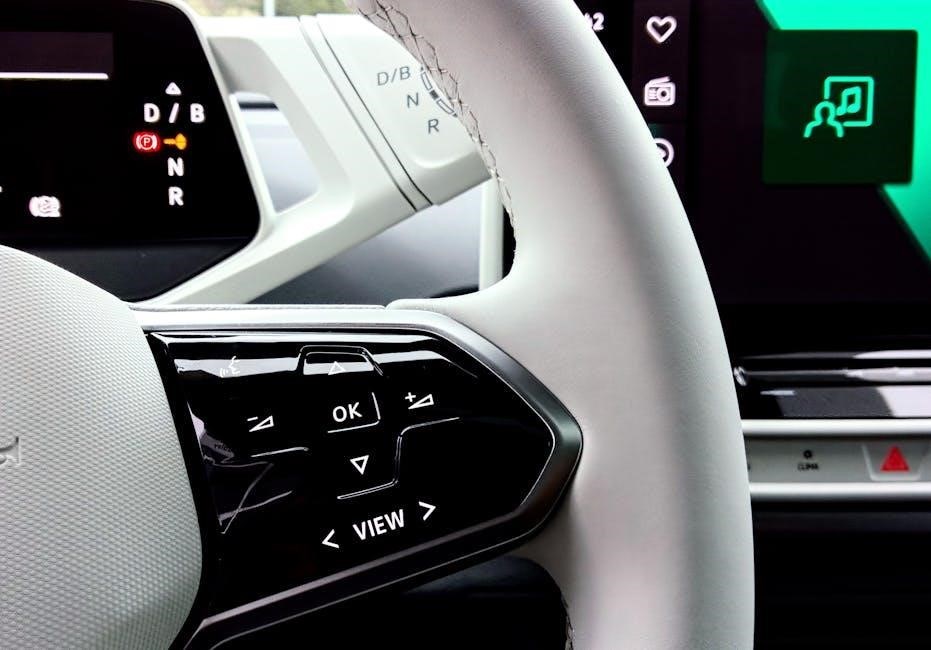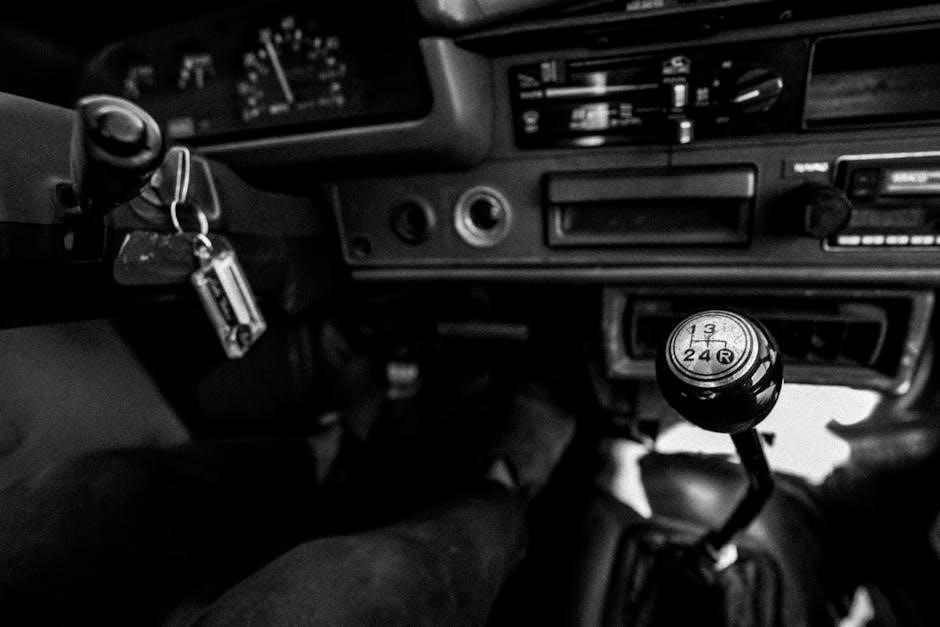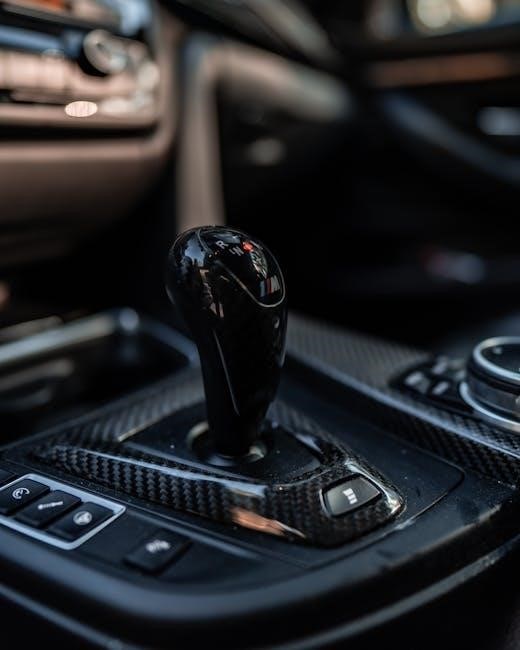
how to reverse manual transmission
Mastering the reverse gear in a manual transmission car is an essential skill for safe and controlled driving. This guide provides detailed steps and expert tips to help you confidently navigate reversing with precision and ease, ensuring smooth operation in various driving conditions.
Understanding the Basics of Manual Transmission
A manual transmission car requires the driver to manually shift gears using the clutch pedal and gearshift. The clutch disconnects the engine from the transmission, allowing smooth gear changes. To reverse, the driver must press the clutch fully, shift into reverse gear, and slowly release the clutch while applying gentle throttle. Unlike forward gears, reverse gear has a unique mechanism to enable backward movement. Each car’s manual transmission setup may vary slightly, but the fundamental principle remains consistent. Mastering this process ensures better control and confidence while reversing.
Why Reversing in a Manual Car is Different
Reversing a manual transmission car differs from automatics due to the need for manual clutch and gear engagement. The driver must press the clutch fully, shift into reverse gear, and coordinate clutch release with gentle throttle input. This process requires more driver involvement and control compared to automatic cars. Additionally, the reverse gear in manual transmissions is mechanically distinct, with a specific gear ratio designed for controlled backward movement. The driver must also consider the car’s engine speed and balance when reversing uphill or downhill, making it a skill that demands practice and understanding of the vehicle’s mechanics.
Mechanical Aspects of Reverse Gear in Manual Transmissions
In manual cars, reverse gear operates with a unique gear ratio, enabling controlled backward movement. It engages mechanically, requiring clutch disengagement and precise gearshift alignment to function effectively.
How Reverse Gear Works
Reverse gear in a manual transmission operates by engaging a specific gear ratio designed for backward movement. To activate it, fully press the clutch pedal and shift the gearstick to the reverse position, typically located to the left of neutral. This mechanism alters the transmission’s internal workings, enabling the engine to power the wheels in the opposite direction. The process requires precise alignment to prevent grinding, ensuring smooth engagement. Once engaged, the car moves backward at a controlled speed, facilitated by the unique gear ratio. This function is essential for maneuvering in tight spaces safely and effectively.
Differences Between Reverse and Forward Gears
Reverse gear operates differently from forward gears due to its unique mechanical design. While forward gears are optimized for varying speeds, reverse gear is a single, specialized gear ratio for backward movement. Engaging reverse requires pressing the clutch fully and shifting precisely, as misalignment can cause grinding. Unlike forward gears, reverse gear is typically located to the left of neutral and may need additional actions, such as pushing down, depending on the car. The car moves slower in reverse, necessitating more careful control and attention. This distinction highlights the importance of understanding reverse gear’s unique characteristics for smooth operation.
Safety Tips for Reversing a Manual Car
Always check your surroundings, use mirrors, and maintain slow speed. Avoid sudden movements and ensure complete control over the clutch and brakes for safe reversing.
Precautions Before Engaging Reverse
Before reversing, ensure your surroundings are clear of obstacles and pedestrians. Always check your rearview and side mirrors for visibility. Look over your shoulder to see blind spots. Keep your foot on the brake pedal and ensure the car is completely stationary. Familiarize yourself with the gearshift’s reverse position to avoid accidental engagement. If driving an unfamiliar car, practice shifting through gears to locate reverse confidently. Never engage reverse while the car is moving forward or backward, as this can damage the transmission. Stay alert and avoid distractions to maintain full control of the vehicle.
Importance of Slow Speed and Control
Maintaining slow speed and control is crucial when reversing a manual transmission car. Sudden movements can lead to loss of control, increasing the risk of accidents. By driving slowly, you gain more time to react to obstacles and adjust your path. Use the clutch and brake pedals smoothly to avoid jerky stops or accelerations. Slow reversing also allows better observation of your surroundings, helping you navigate tight spaces safely. Avoid rushing, as precise control ensures a safer and more accurate reversal, especially in confined areas or uphill/downhill scenarios.
Step-by-Step Guide to Engaging Reverse Gear
Engage reverse by moving the shifter to the left of neutral, often requiring a gentle press. Use mirrors, ensure slow speed, and control clutch smoothly for safe reversal.
Finding the Reverse Gear Position
Locating reverse gear in a manual transmission typically involves moving the gear shifter to the left of neutral. In most vehicles, reverse is the first gear to the left, often requiring a slight press downward on the shifter. Some cars may have a different setup, so familiarizing yourself with the gear layout is crucial. Always ensure the car is stationary and the clutch is fully pressed before attempting to engage reverse. Practice shifting through all gears to understand the specific positioning of reverse in your vehicle for smooth operation.

Using the Clutch and Brake Pedals Effectively
Mastering the use of clutch and brake pedals is critical when reversing a manual transmission car. Always start by fully pressing the clutch pedal to disengage the engine from the transmission. Slowly release the clutch while gently pressing the accelerator to maintain control. Use the brake pedal to regulate speed, especially on inclines or declines. Avoid sudden movements, as this can lead to stalling or loss of control. When reversing uphill, slight throttle input may be needed to prevent rolling backward. Practice in a safe, open area to refine your coordination of these pedals for smooth and precise reversing maneuvers.

Mastering the Art of Reversing
Practice slow, controlled movements and use mirrors effectively to build confidence in reversing a manual car. Regular practice helps refine steering techniques and straight-line corrections.
Steering Techniques for Reverse Driving
Mastering steering techniques is crucial for reversing a manual transmission car. When driving in reverse, the rear wheels guide the vehicle, making steering more sensitive. Small movements can lead to significant changes in direction, so smooth, deliberate turns are essential. To maintain control, keep your speed slow and use reference points like road markings or curb edges to align the car; Looking over your shoulder provides better visibility, while mirrors help monitor surroundings. Practice in open spaces to refine your skills and build confidence in navigating tight spaces safely and effectively.
Maintaining a Straight Line and Making Adjustments
Maintaining a straight line while reversing a manual transmission car requires precise control and constant adjustments. The rear wheels steer the car, so slight movements of the steering wheel can cause significant shifts in direction. To stay aligned, focus on reference points like road markings or the edge of the curb. Check your mirrors frequently and glance over your shoulder for a clear view. If the car begins to drift, make small, gradual corrections to realign. Practice in open areas to develop muscle memory and improve your ability to maintain a straight path effortlessly while reversing.

Reversing on Inclines and Declines
Reversing on inclines and declines requires careful balance of the throttle and clutch. Use the handbrake to stabilize the car and avoid rolling. Gravity increases the challenge, so slow, controlled movements are essential to maintain control and prevent stalling or unintended acceleration.
Special Considerations for Uphill and Downhill Reversing

Reversing uphill or downhill demands extra caution due to gravity’s impact on the vehicle. When reversing uphill, slight throttle input is necessary to prevent stalling, while downhill reversing requires careful brake control to avoid excessive speed. Always use the handbrake for stability and balance. Ensure slow, deliberate movements, and be vigilant for obstacles. Uphill reversing may require higher RPM to maintain control, while downhill situations benefit from light clutch engagement and gradual acceleration. Practice these maneuvers in safe, open spaces to build confidence and mastery over the unique challenges of inclined surfaces.
Using the Handbrake and Balancing Throttle
The handbrake and throttle are crucial when reversing uphill or downhill. Engage the handbrake before shifting into reverse to prevent rolling. On inclines, release the handbrake gradually while pressing the clutch and applying slight throttle. For descents, use the brake pedal to control speed and maintain balance. Avoid sudden movements; instead, coordinate the clutch and accelerator smoothly. Properly balancing the throttle ensures stability and prevents stalling, especially uphill. Always keep the handbrake ready for emergencies and use it to secure the car when stopped on slopes. This technique enhances control and safety during reversing maneuvers.
Reversing a manual transmission car requires coordination of clutch, throttle, and steering. With practice, you’ll master the technique, ensuring smooth and controlled movements. Always use mirrors and look over your shoulder for visibility. On inclines, balance the handbrake and throttle to maintain stability. Remember, slow and deliberate actions are key to safe reversing. Patience and consistent practice will build your confidence and skill, making reversing a manual car second nature. Stay alert, follow safety guidelines, and you’ll navigate reverse gears effortlessly, whether on flat ground or challenging terrain.